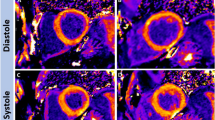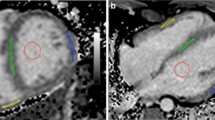Abstract
We compare a saturation recovery arrhythmia insensitive rapid (AIR) T1 mapping technique which is less sensitive to heart rate and requires shorter breath-holds to modified Look-Locker inversion recovery (MOLLI) T1 mapping in patients with mitral valve prolapse. 55 patients underwent AIR and MOLLI at 1.5 T. AIR and MOLLI-derived blood and myocardial T1 values and extracellular volume (ECV) were measured by two independent readers. T1 values and ECV from both techniques and inter-reader agreement were compared with Lin’s concordance correlation coefficient (LCC) and reduced major axis regression. T1 values were consistently overestimated for AIR compared to MOLLI and vice versa for ECV. In the mitral valve prolapse population, mean native and post contrast myocardial T1 value for MOLLI were 1000 ± 40 ms and 411.9 ± 44.2 ms respectively and 1090.6 ± 58.7 ms and 488.2 ± 45.7 ms for AIR. Mean native and post contrast blood T1 values for MOLLI were 1566.6 ± 72.3 ms and 276.6 ± 34.1 ms respectively versus 1657.2 ± 180.9 ms and 294.9 ± 35.6 ms for AIR. AIR underestimated ECV relative to MOLLI (23.5 ± 0.4% vs 27.7 ± 0.4%). We found excellent inter-reader agreement (LCC all > 0.94, p < 0.0001) for both AIR and MOLLI techniques as well as intra-reader reliability (LCC all > 0.97, p < 0.0001). AIR can be performed in patients with mitral valve prolapse with excellent inter and intra-reader agreement, with higher T1 values compared to MOLLI, in line with other saturation recovery techniques. A consistent T1 mapping technique should be used when performing serial imaging.




Similar content being viewed by others
Data availability
The data will be kept with the corresponding author. Electronic records will be password encrypted. Data will be available to be reviewed by the journal if requested.
References
Hayek E, Gring CN, Griffin BP (2005) Mitral valve prolapse. The Lancet 365(9458):507–518
Freed LA, Levy D, Levine RA, Larson MG, Evans JC, Fuller DL et al (1999) Prevalence and clinical outcome of mitral-valve prolapse. N Engl J Med 341(1):1–7
Nishimura RA, McGoon MD, Shub C, Miller FA Jr, Ilstrup DM, Tajik AJ (1985) Echocardiographically documented mitral-valve prolapse Long-term follow-up of 237 patients. N Engl J Med. 313(21):1305–1309
Han HC, Ha FJ, Teh AW, Calafiore P, Jones EF, Johns J et al (2018) Mitral Valve Prolapse and Sudden Cardiac Death: A Systematic Review. J Am Heart Assoc 7(23):e010584
Bui AH, Roujol S, Foppa M, Kissinger KV, Goddu B, Hauser TH et al (2017) Diffuse myocardial fibrosis in patients with mitral valve prolapse and ventricular arrhythmia. Heart 103(3):204
Perazzolo Marra M, Basso C, De Lazzari M, Rizzo S, Cipriani A, Giorgi B et al (2016) Morphofunctional Abnormalities of Mitral Annulus and Arrhythmic Mitral Valve Prolapse. Circ Cardiovasc Imaging 9(8):e005030
Basso C, Perazzolo Marra M, Rizzo S, De Lazzari M, Giorgi B, Cipriani A et al (2015) Arrhythmic Mitral Valve Prolapse and Sudden Cardiac Death. Circulation 132(7):556–566
Han HC, Parsons SA, Teh AW, Sanders P, Neil C, Leong T et al (2020) Characteristic Histopathological Findings and Cardiac Arrest Rhythm in Isolated Mitral Valve Prolapse and Sudden Cardiac Death. J Am Heart Assoc 9(7):e015587
Thakrar D, Collins J, Rustogi R, Kino A, Zuehlsdorff S, Carr J (2012) T2 Mapping of the myocardium, a quantitative tool for assessment of myocarditis. J Cardiovasc Magn Reson. 14(1):P177–P178
Radenkovic D, Weingartner S, Ricketts L, Moon JC, Captur G (2017) T<sub>1</sub> mapping in cardiac MRI. Heart Fail Rev 22(4):415–430
Agarwal C, Santos-Gallego C, Requena-Ibanez JA, Weiss A, Smoller R, Fuster V et al (2017) T1 MAPPING ASSESSES DIAGNOSIS, SEVERITY AND PROGNOSIS IN ACUTE MYOCARDITIS. J Am Coll Cardiol 69(11):1443
Maron MS, Maron BJ, Harrigan C, Buros J, Gibson CM, Olivotto I et al (2009) Hypertrophic cardiomyopathy phenotype revisited after 50 years with cardiovascular magnetic resonance. J Am Coll Cardiol 54(3):220–228
Puntmann VO, Isted A, Hinojar R, Foote L, Carr-White G, Nagel E (2017) T1 and T2 Mapping in Recognition of Early Cardiac Involvement in Systemic Sarcoidosis. Radiology 285(1):63–72
Basso C, Iliceto S, Thiene G, Perazzolo MM (2019) Mitral Valve Prolapse, Ventricular Arrhythmias, and Sudden Death. Circulation 140(11):952–964
Roujol S, Weingartner S, Foppa M, Chow K, Kawaji K, Ngo LH et al (2014) Accuracy, precision, and reproducibility of four T1 mapping sequences: a head-to-head comparison of MOLLI, ShMOLLI, SASHA, and SAPPHIRE. Radiology 272(3):683–689
Fitts M, Breton E, Kholmovski EG, Dosdall DJ, Vijayakumar S, Hong KP et al (2013) Arrhythmia insensitive rapid cardiac T1 mapping pulse sequence. Magn Reson Med 70(5):1274–1282
Robison S, Hong K, Kim D, Lloyd R, Ramchand J, Hornsey E et al (2018) Evaluation of Modified Look-Locker Inversion Recovery and Arrhythmia-Insensitive Rapid Cardiac T1 Mapping Pulse Sequences in Cardiomyopathy Patients. J Comput Assist Tomogr 42(5):732–738
Gunasekaran S, Lee DC, Knight BP, Collins JD, Fan L, Trivedi A, et al. Left ventricular extracellular volume expansion does not predict recurrence of atrial fibrillation following catheter ablation. Pacing and Clinical Electrophysiology. 2019;
Kellman P, Wilson JR, Xue H, Bandettini WP, Shanbhag SM, Druey KM et al (2012) Extracellular volume fraction mapping in the myocardium, part 2: initial clinical experience. J Cardiovasc Magn Reson 14(1):64
Messroghli DR, Radjenovic A, Kozerke S, Higgins DM, Sivananthan MU, Ridgway JP (2004) Modified Look-Locker inversion recovery (MOLLI) for high-resolution T1 mapping of the heart. Magn Reson Med 52(1):141–146
Haaf P, Garg P, Messroghli DR, Broadbent DA, Greenwood JP, Plein S (2016) Cardiac T1 Mapping and Extracellular Volume (ECV) in clinical practice: a comprehensive review. J Cardiovasc Magn Reson 18(1):89
Ludbrook J (2010) Linear regression analysis for comparing two measurers or methods of measurement: but which regression? Clin Exp Pharmacol Physiol 37(7):692–699
Ludbrook J (2002) Statistical techniques for comparing measurers and methods of measurement: a critical review. Clin Exp Pharmacol Physiol 29(7):527–536
Landis JR, Koch GG (1977) The Measurement of Observer Agreement for Categorical Data. Biometrics 33(1):159–174
Kellman P, Herzka DA, Arai AE, Hansen MS (2013) Influence of Off-resonance in myocardial T1-mapping using SSFP based MOLLI method. J Cardiovasc Magn Reson 15(1):63
Robson MD, Piechnik SK, Tunnicliffe EM, Neubauer S (2013) T1 measurements in the human myocardium: the effects of magnetization transfer on the SASHA and MOLLI sequences. Magn Reson Med 70(3):664–670
Costello BT, Springer F, Hare JL, Gerche AL, Iles L, Ellims AH et al (2017) SASHA versus ShMOLLI: a comparison of T1 mapping methods in health and dilated cardiomyopathy at 3 T. Int J Cardiovasc Imaging 33(10):1551–1560
Messroghli DR, Greiser A, Frohlich M, Dietz R, Schulz-Menger J (2007) Optimization and validation of a fully-integrated pulse sequence for modified look-locker inversion-recovery (MOLLI) T1 mapping of the heart. J Magn Reson Imaging 26(4):1081–1086
Sussman MS, Wintersperger BJ (2019) Modified look-locker inversion recovery (MOLLI) T1 mapping with inversion group (IG) fitting – A method for improved precision. Magn Reson Imaging 62:38–45
Kellman P, Arai AE, Xue H (2013) T1 and extracellular volume mapping in the heart: estimation of error maps and the influence of noise on precision. J Cardiovasc Magn Reson 15(1):56
Jellis CL, Kwon DH (2014) Myocardial T1 mapping: modalities and clinical applications. Cardiovasc 4(2):126–137
Chow K, Flewitt J, Pagano JJ, Green JD, Friedrich MG, Thompson RB (2012) T(2)-dependent errors in MOLLI T(1) values: simulations, phantoms, and in-vivo studies. J Cardiovasc Magn Reson. 14(1):281–284
Kellman P, Herzka DA, Hansen MS (2014) Adiabatic inversion pulses for myocardial T1 mapping. Magn Reson Med 71(4):1428–1434
Shao J, Liu D, Sung K, Nguyen K-L, Hu P (2017) Accuracy, precision, and reproducibility of myocardial T1 mapping: A comparison of four T1 estimation algorithms for modified look-locker inversion recovery (MOLLI). Magn Reson Med 78(5):1746–1756
Hong K, Collins J, Lee DC, Wilcox JE, Markl M, Carr J et al (2016) Optimized AIR and investigational MOLLI cardiac T1 mapping pulse sequences produce similar intra-scan repeatability in patients at 3T. NMR Biomed 29(10):1454–1463
Dabir D, Child N, Kalra A, Rogers T, Gebker R, Jabbour A et al (2014) Reference values for healthy human myocardium using a T1 mapping methodology: results from the International T1 Multicenter cardiovascular magnetic resonance study. J Cardiovasc Magn Reson 16:69
Gunasekaran S, Lee DC, Knight BP, Collins JD, Fan L, Trivedi A, et al. Left ventricular extracellular volume expansion does not predict recurrence of atrial fibrillation following catheter ablation. Pacing Clin Electrophysiol. 2019.
Kellman P, Hansen MS (2014) T1-mapping in the heart: accuracy and precision. J Cardiovasc Magn Reson 16:2
Kawel N, Nacif M, Zavodni A, Jones J, Liu S, Sibley CT et al (2012) T1 mapping of the myocardium: intra-individual assessment of post-contrast T1 time evolution and extracellular volume fraction at 3T for Gd-DTPA and Gd-BOPTA. J Cardiovasc Magn Reson 14:26
Zhao L, Li S, Ma X, Greiser A, Zhang T, An J et al (2016) Systolic MOLLI T1 mapping with heart-rate-dependent pulse sequence sampling scheme is feasible in patients with atrial fibrillation. J Cardiovascular Magnetic Resonance 18:13
Schelbert EB (2016) Messroghli DR State of the Art: Clinical Applications of Cardiac T1 Mapping. Radiology 278(3):658–676
Acknowledgements
The authors thank Austin Health’s MRI radiography team for scanning the patients.
Author information
Authors and Affiliations
Corresponding author
Ethics declarations
Conflicts of interest
All authors declare no conflict of interest or funding.
Additional information
Publisher's Note
Springer Nature remains neutral with regard to jurisdictional claims in published maps and institutional affiliations.
Rights and permissions
About this article
Cite this article
Cheung, E., Han, HC., Hornsey, E. et al. Arrhythmia insensitive rapid cardiac T1 mapping: comparison to modified look locker inversion recovery T1 mapping in mitral valve prolapse patients. Int J Cardiovasc Imaging 36, 2017–2025 (2020). https://doi.org/10.1007/s10554-020-01910-9
Received:
Accepted:
Published:
Issue Date:
DOI: https://doi.org/10.1007/s10554-020-01910-9




